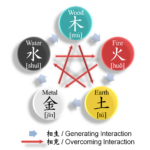
Five Elements (Wu Xing) symbol
| Symbol | Five Elements (Wu Xing) |
| Religion | Taoism |
| Origin | Rooted in ancient Chinese cosmology. |
| Meaning | Represents the dynamic interactions of five elemental forces (wood, fire, earth, metal, water). |
| Appearance | Symbolic representations of each element. |
| Colors | Corresponding colors associated with each element. |
| Usage | Utilized in Taoist cosmology, traditional Chinese medicine, and Feng Shui. |
| History | Integral to Taoist and Chinese philosophical traditions. |
| Popularity | Widely employed in various cultural and spiritual practices. |
| Importance | Represents the cyclical nature of change in the cosmos. |
| Complexity | Each element has specific associations and interactions. |
| Emotions | Elicits a sense of balance, cycles, and natural harmony. |